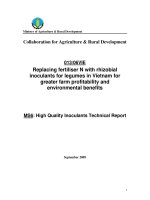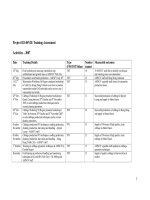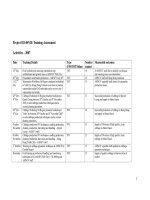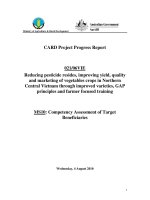Báo cáo khoa học nông nghiệp " Reducing pesticide resides, improving yield, quality and marketing of vegetables crops in Northern Central Vietnam through improved varieties, GAP principles and farmer focused training " MS8 doc
Bạn đang xem bản rút gọn của tài liệu. Xem và tải ngay bản đầy đủ của tài liệu tại đây (51.72 KB, 8 trang )
1
Ministry of Agriculture & Rural Development
Project Progress Report
021/06VIE
Reducing pesticide resides, improving yield, quality
and marketing of vegetables crops in Northern
Central Vietnam through improved varieties, GAP
principles and farmer focused training
MS8: Fourth Six-Monthly Report
1
Table of Contents
1. Institute Information ___________________________________________________ 2
2. Project Abstract _______________________________________________________ 4
3. Executive Summary ____________________________________________________ 4
4. Introduction & Background _____________________________________________ 4
5. Progress to Date _______________________________________________________ 5
5.1 Implementation Highlights ________________________________________________ 5
5.2 Capacity Building ________________________________________________________ 6
5.3 Publicity________________________________________________________________ 6
5.4 Project Management _____________________________________________________ 6
5.5 Environment ____________________________________________________________ 7
5.6 Gender and Social Issues __________________________________________________ 7
6. Implementation & Sustainability Issues ____________________________________ 7
6.1 Issues and Constraints ____________________________________________________ 7
6.2 Options_________________________________________________________________ 7
6.3 Sustainability____________________________________________________________ 7
7. Next Critical Steps _____________________________________________________ 7
8. Conclusion ___________________________________________________________ 7
2
1. Institute Information
Project Name
Reducing pesticide residues, improving
yield, quality and marketing of
vegetable crops in Northern Central
Vietnam through improved varieties,
GAP principles and farmer focused
training
Vietnamese Institution
Agricultural Science Institute for
Northern Central Vietnam.
(“ASINCV”)
Nghi Kim,
Vinh city,
Nghe An province, Vietnam
Vietnamese Project Team Leader
Dr Chuong
Australian Organisation
Applied Horticultural Research Pty.
Ltd.(AHR) ACN 073 642 510
Suite 352 Biomedical Building
1 Central Ave
Eveleigh NSW 2015 Australia
Australian Personnel
Prof. Gordon Rogers
Date commenced March 2007
Completion date (original)
July 2008
Completion date (revised)
July 2008
Reporting period
Milestone achieved December 2008
3
Contact Officer(s)
In Australia: Team Leader
Name:
Assoc Prof. Gordon Rogers
Telephone:
+61 2 8627 1040
Position:
Project Leader
Fax:
+61 2 9544 3782
Organisation
AHR, Applied Horticultural
Research
Suite 352 Biomedical
Building
1 Central Ave
Eveleigh NSW 2015
Australia
Email:
In Australia: Administrative contact
Name:
Lynn Christie
Telephone:
+61 2 9527 0826
Position:
Administrator
Fax:
+61 2 9544 3782
Organisation
AHR, Applied Horticultural
Research
PO Box 3114
Bundeena NSW 2230
Australia
Email:
In Vietnam
Name:
Dr Pham Van Chuong
Telephone:
+84 (903) 221 612
Position:
Team Leader Vietnam
Fax:
+84(0) 38 851 981
Organisation
Agricultural Science
Institute for Northern
Central Vietnam.
(“ASINCV”)
Nghi Kim,
Vinh city,
Nghe An province,
Vietnam
Email:
4
2. Project Abstract
3. Executive Summary
The project uses a participatory approach to encourage the uptake of good agricultural
practices (GAP) by the collaborating Vietnamese Institutes and the stakeholders (farmers,
extension staff and commercial partners). The project includes several training initiatives.
Such as the establishment of demonstration variety and GAP trials which are the basis of
farmer field days, postharvest research investigating temperature management and packaging
along the supply chain and market development.
The project is running well and during this reporting period has focused on the review of
input from Mr Titley (visit June 2008) on problems with the previous watermelon crop and
address for the following crop. This resulted in a new watermelon production site at Dien
Phong. Watermelons were successfully supplied to Metro Cash and Carry in Hanoi, following
up the success of the previous cabbage crop. The traditional and supermarket system for
watermelons and cabbage were studied.
Training was delivered on agronomy, supply and marketing of cabbage in preparation for the
coming winter crop in the form of Farmer Field Schools.
Crop supply scheduling tools were developed which can be used to assist farmers in
developing planting schedules to meet retail orders and also to monitor crop progress. This
helped with the expansion of the number from crops being supplied to Metro from Quynh
Luong from 2 to 5 to include carrots, tomatoes and chinese cabbage. There were two visits by
the Australian team to Vietnam during this time.
4. Introduction & Background
Vegetable growing in Vietnam is an important source of income for the country and accounts
for 9% of the total cropping including rice.
There is potential to increase these returns to growers by maximizing yield and quality of the
produce they grow. However, there are several aspects of the vegetable industry in Vietnam
which currently limit expansion and development of the industry and financial returns to
farmers, i.e.:
Vegetable farming in Vietnam can bring an attractive income of around 20-30 Million VND per
year which represents 80-90% of the average farming family income. There is potential to
increase these returns to growers by maximizing yield and quality of the produce they grow. This
project aims to improve the income of smallholders by encouraging them to adopt clean and
sustainable production practices. This will involve providing high yielding; disease resistant
varieties of watermelon and cabbage, providing information and training in Good Agricultural
Practice. The introduction of new varieties and GAP will be implanted using a participatory
approach with farmer field days and workshops lead by leading Australian industry consultants.
The highlight from this reporting period is the production of high quality cabbages using GAP at
Quynh Luong Commune and Hung Duong Co-operative and the enthusiasm from Metro Cash and
Carry to sell these products in the Hanoi store. This is a very positive step for developing an
alternative supply chain for these farmers which could be more reliable and profitable than the
existing ones they use. The use of IPM and the agronomic record books has also been an
important first steps for the adoption of a QA system for the growers.
5
• High pesticide and nitrosamine residues in produce
• Postharvest temperature management and handling technology limits the quality
presented to consumers
• Agronomic practices used by growers can limit potential yields and hence farmer
income
• Traditional marketing can limit farmer returns
The project will use a participatory approach to encourage the uptake of good agricultural
practices (GAP) by the collaborating Vietnamese Institutes and the stakeholders (farmers,
extension staff and commercial partners). The project will include several training initiatives.
These include the establishment of demonstration variety and GAP trials which will be the
basis of farmer field days, postharvest research investigating temperature management and
packaging along the supply chain, intensive training of Vietnamese horticulturalists in
Australia and the delivery of a large workshop at the end of the project to ensure the
information is available to as wide an audience as possible.
Another important aim is to develop a new and reliable market for growers by establishing
supply chain links with Metro supermarkets. This will mean that the number of steps in the
supply chain will be reduced and the product will reach the final customers more quickly,
resulting in a fresher product with increased demand and sales. As a result, farmers will
benefit through increased sales, more reliable markets, better communication with product
buyers and in turn better returns. Retailers benefit through reliable supplies of consistent
clean product that meets their specifications and thus improving their sales and returns.
The project is focussed on outdoor farmers adopting methods to produce clean high quality
vegetables by:
o New varieties
o Good Agricultural Practice (GAP)
o Participatory training
o Postharvest research and training
o Developing supply chain links
5. Progress to Date
5.1 Implementation Highlights
The main activities undertaken since the last six-monthly report (milestone 6) include:
(i) Review input from Mr Titley (visit June 2008) on problems with the previous
watermelon crop and address for the following crop.
(ii) Finding a new watermelon production site for next season as an alternative to Hung
Dong where the soil is too heavy. The new site is at Dien Phuong and has light
sandy soils with well developed infrastructure for vegetable growing.
(iii) Successfully supplied watermelons to Metro Cash and Carry in Hanoi, following up
the success of the previous cabbage crop. There were some issues with root
diseases, especially Fusarium sp. and this resulted in a lower than expected
delivery to Metro. The expected delivery was 100 tonnes, but only about 70% of
this was delivered due to poor yields from the Hung Dong Collective.
6
(iv) Study of the traditional marketing system for watermelons and cabbage undertaken
and compared to the supply chain for supermarkets. This report will be supplied
with milestone 7.
(v) Deliver training on agronomy, supply and marketing of cabbage in preparation for
the coming winter crop in the form of Farmer Field Schools. A report on training
activities in included with this milestone report as an attachment.
(vi) Crop supply scheduling tools were developed which can be used to assist farmers in
developing planting schedules to meet retail orders and also to monitor crop
progress. Crop planting and supply tools have been developed in the form of
Excel ® spreadsheets. The tools were developed for cabbage, watermelon,
chinese cabbage, tomatoes and carrots. The starting point is the quantity and time
each consignment is required by the retailer. For example, 5 tonnes of cabbage
per week from January to March. Then, the program determines planting dates,
numbers of seed or seedlings required, area required each week to produce the
required amounts of produce
(vii) Expansion of the number from crops being supplied to Metro from Quynh Luong
from 2 to 5 to include carrots, tomatoes and chinese cabbage.
(viii) There were two visits by the Australian team to Vietnam during this time.
Dates Who went Objective(s) of Trip Activities
22
nd
September –
3
rd
October
2008
Gordon Rogers
Jenny Jobling
Review planning for coming
cabbage season Find new
watermelon site. Deliver training on
Cabbage agronomy
Visit QL and DP sites
FFS at QL and HD
10-17
th
December
2008
Gordon Rogers
John Baker
Plan crop supply schedules.
Plan for supply of other vegetable
crops, especially from QL
Plan supply schedules
Review current cabbage
and other plantings
5.2 Capacity Building
Skills have been built in by providing training especially in the recognition and management
of root diseases in watermelons. It was also assisted through the development of computer-
based crop supply tools which simplify the process of supplying set amounts of produce on a
regular basis to meet supermarket requirements. Training was provided to farmers, ASINCV
staff and Metro on the use of these tools.
5.3 Publicity
No particular activities to report.
5.4 Project Management
The project activities have been progressing as per the schedule in the project logframe. The
submission of milestone reports has been slow and this has affected cash flow to fund project
operations. Applied Horticultural Research has made payments to ASINCV in advance of
7
receiving payments from CARD to keep things moving and this has been successful. The
current plan is to have all outstanding milestone reports submitted by the end of March 2010.
5.5 Environment
The farmers participating in the project were been provided with feedback that on one
occasion, high pesticide residue levels were found in their produce (reported in milestone 4).
This problem has been solved and no further incidences of high pesticide residues have been
found.
5.6 Gender and Social Issues
This project will continue to address gender and social issues by trying to improve the income
of local farmers by facilitating a linkage between the growers and Metro Cash and Carry.
6. Implementation & Sustainability Issues
6.1 Issues and Constraints
There have been no significant issues which have compromised project activities.
6.2 Options
Nil
6.3 Sustainability
No sustainability issues.
7. Next Critical Steps
Continue with training and developing skills of farmers. Successfully supply the next cabbage
crop to Metro and also the new vegetable species. Continue to improve skills in post harvest
handling and IPM (problem identification and management options). Improve farmers
understanding of the role of market requirements in scheduling of production, product quality
and post-harvest handling.
8. Conclusion
Will be covered in the project final report.
Attachments
Training and Marketing Report
Vegetable crop supply tools (Excel)









